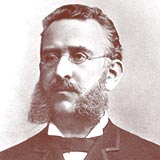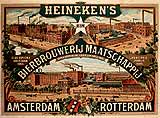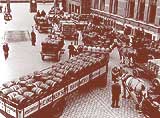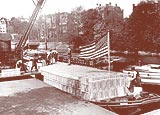 The
world of beer changed when a well-dressed man with an impeccable moustache decided
to back a belief that he could create a brewing industry. At 22-years-old, he
had an entrepreneurial spirit and the courage to follow his convictions.
The
world of beer changed when a well-dressed man with an impeccable moustache decided
to back a belief that he could create a brewing industry. At 22-years-old, he
had an entrepreneurial spirit and the courage to follow his convictions. The
world of beer changed when a well-dressed man with an impeccable moustache decided
to back a belief that he could create a brewing industry. At 22-years-old, he
had an entrepreneurial spirit and the courage to follow his convictions.
The
world of beer changed when a well-dressed man with an impeccable moustache decided
to back a belief that he could create a brewing industry. At 22-years-old, he
had an entrepreneurial spirit and the courage to follow his convictions.
It was 1863 and no-one had heard of Gerard Adriaan Heineken.
Businessmen raised their eyebrows when he bought the loss-making Haystack brewery
in the centre of Amsterdam. With no brewing experience, it was a colossal undertaking
but Heineken resolved to ‘the utmost effort and painstaking care and will
leave no remedy untried to persist in supplying the best quality beer in the
long term.’ Heineken & Co was born. Heineken swept into the brewery
like a whirlwind, energising the workforce, revamping procedures and instilling
confidence. He celebrated his first year by boosting pre-Heineken production
of 2,100 barrels to 5,000 barrels and a move to bigger, more modern premises
on the outskirts of the city.
The Vision
But a new process called ‘bottom-fermentation’, producing a clearer beer with a longer life, was challenging traditional methods. The astute Heineken investigated and researched and knew his company had to change from methods that realised heavier and unstable brews. The best master brewers were hired and, in 1870, Heineken started to sell its new range of pilsner beer and soon the company was struggling to keep pace with demand. Heineken’s vision had paid off again. He was still only 28-years-old. Continued expansion saw another new plant open in Rotterdam in 1874. Heineken chased sales succesfully, but refused to compromise on quality.
Beer sales soared and Heineken started exporting to England,
Belgium and northern France. Gerard Heineken became captivated with Paris and
was keen to break into the French market. He was overjoyed when his company
won the contract to supply the Folies Bergeres, home of the Can-Can girls!
Perfect Beer
 In
1884, the distinctive green Heineken label was registered as a trademark. To
Heineken there was always a magic about brewing and he commissioned experimental
laboratories to chase the dream of the ‘perfect beer’. He employed
Dr H. Elion, a pupil of Louis Pasteur, to find the key to a uniform taste.
In
1884, the distinctive green Heineken label was registered as a trademark. To
Heineken there was always a magic about brewing and he commissioned experimental
laboratories to chase the dream of the ‘perfect beer’. He employed
Dr H. Elion, a pupil of Louis Pasteur, to find the key to a uniform taste.
It arrived in the form of "A" yeast -still used today - which had quality and stability. Introduced to the brewing process in 1886, it enabled Heineken to achieve purity and consistency. It was a landmark in brewing. The A-yeast is still a vital part of Heineken’s brewing and it is used in all of its 110 breweries. From the main brewery in Zoeterwoude, the Netherlands, it is transported around the world in special cases and gets almost diplomatic honours in its journeys. The A-yeast is sent to all breweries every month in order to maintain the consistent quality of the beer, Heineken is known for. The brewery won the Grand Prix de Paris in 1889 and the next year became the supplier of beer to the Eiffel tower restaurant as befits its elevated status. Heineken continued to innovate in the brewery process and to explore expansion around Europe and the world.
Gerard Heineken died on March 18, 1893 but his legacy
was a brewery selling 200,000 hectolitres of beer each year – at the time
the average Dutch brewery was selling just 3,000 hectolitres.
The "Red Brewer"
 Sales
continued to rise and Gerard’s 28-year-old son Dr Henry Pierre Heineken
was appointed a director in 1914 and three years later became chairman. He carried
the family torch and was nicknamed the ‘Red Brewer’ for his commitment
to his workforce and because he was the first employer in Holland to set up
a pension scheme for the workers, which came into force on the company’s
50th anniversary.
Sales
continued to rise and Gerard’s 28-year-old son Dr Henry Pierre Heineken
was appointed a director in 1914 and three years later became chairman. He carried
the family torch and was nicknamed the ‘Red Brewer’ for his commitment
to his workforce and because he was the first employer in Holland to set up
a pension scheme for the workers, which came into force on the company’s
50th anniversary.
He also encouraged a rapid international expansion which was possible because the ‘A’ Yeast had ensured that consistent quality could be achieved anywhere. The Heineken family had always thought globally and in the early 1930s took its first tentative steps in Asia. In 1931, the first Heineken brewery was opened near the Indonesian city of Suabaya.
Two years later, another was established – together
with soft drinks producer Fraser & Neave: Malayan Breweries – in Singapore
and it
is now known as Asia Pacific Breweries. Heineken remained eagle-eyed for new
opportunities and three days after Prohibition ended in the USA, a shipment
of Heineken beer was unloaded at the New Jersey port of Hoboken – it has
been the most popular European beer in the States ever since. Exports were a
fertile market throughout the early 1930s but the advent of world war II brought
production to a near standstill. Heineken had to raise its marketing strategy
to live again. The year 1946 was a hugely significant year in the company’s
development. The now famous green was introduced and it made Heineken the most
exclusive imported beer in the USA. At the same time, Henry’s son, Alfred
Henry Heineken, became the third generation in the family business, which had
drifted away from family ownership. He was to preside over huge creativity and
global activity.
Million Seller
With the world still struggling to find a way back from world war II and Heineken’s finances in need of repair, Alfred decided to gamble – he hired an expensive Jaguar car, impressed the banks and launched a successful campaign to buy the company back.
 In
1960, the company hit the landmark of selling one million 24-bottle cases in
the USA. On January 1, 1968, the first Heineken advertisements appeared on Dutch
television but Heineken was struggling in the European market. He ploughed his
drive and creativity into conquering the continent by shrewd acquisitions and
mergers along with innovative advertising. In 1970, the company had just 2.8
per cent of the market. In the 70s and 80s, the world beer market grew by 181
per cent but Heineken’s turnover increased by 465 per cent.
In
1960, the company hit the landmark of selling one million 24-bottle cases in
the USA. On January 1, 1968, the first Heineken advertisements appeared on Dutch
television but Heineken was struggling in the European market. He ploughed his
drive and creativity into conquering the continent by shrewd acquisitions and
mergers along with innovative advertising. In 1970, the company had just 2.8
per cent of the market. In the 70s and 80s, the world beer market grew by 181
per cent but Heineken’s turnover increased by 465 per cent.
Today, Heineken is the largest brewer in Europe with an 11 per cent share and Heineken is Europe’s most popular beer. The company brews more than 98 million hectolitres of beer, which, if placed in 33 cl bottles, could encircle the earth 45 times. Production takes places in over 110 breweries in more than 50 countries. The results are a testimony to the great vision of three generations of a remarkable family. Heineken was lauded as ‘Brand of the Century’ and Alfred, who resigned as chairman in 1989, as ‘Advertiser of the Century’ in the Netherlands in 1999. The awards and figures display the commercial reality of Heineken’s success but the independent mind, creative spirit and disciplined will are the emotional charges that have run through the company for almost 140 years.
Alfred Heineken, speaking in 2000, prefers the modest approach, putting it simply: ‘People often ask me whether I like seeing my name all over the world. It doesn’t bother me. There’s a Dutch saying that goes: Madmen and asses write on walls and glasses. Well, that’s exactly what I do.’
Internationalisation
Thanks to it's timely turn to internationalisation and quick reaction to changes in the international beer market Heineken N.V. is now the world's top international beer producer. Heineken N.V. 's products can be found in more than 200 countries all over the globe while the company’s intentions to expand in the existing markets and in new ones are still on.